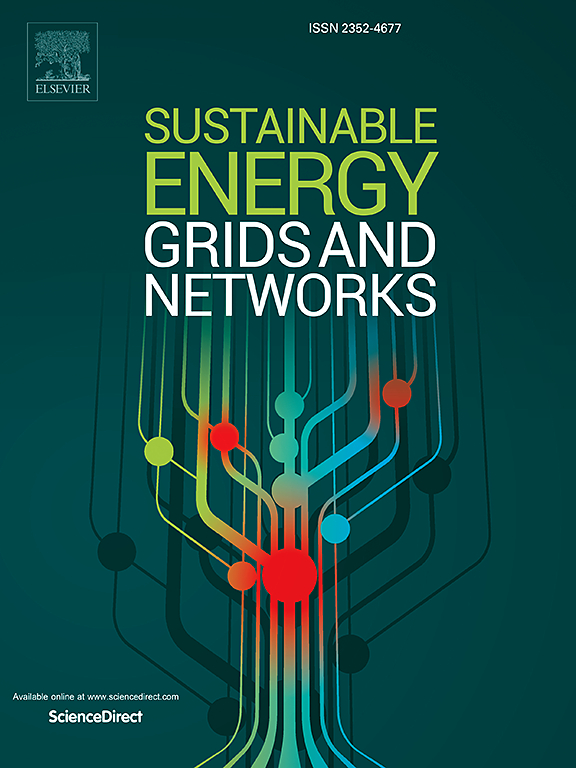Research on superposition-level dual power allocation control strategy for energy storage integration in electrified oil rigs: Load shock mitigation and energy utilization efficiency
IF 5.6
2区 工程技术
Q2 ENERGY & FUELS
引用次数: 0
Abstract
Changes in geological and working conditions during drilling result in the intermittent and cyclical operation of high-power equipment on oil drilling rigs, which leads to substantial alternating load impacts on the grid. To address this problem, this paper collects full-cycle and full-operating power data and operating parameters from "electrified" oil rigs. The power fluctuation characteristics have been derived under multiple operating conditions and multi-dimensional variables. A physically-coupled, hierarchical control strategy utilizing a storage system is proposed to address grid stability and power supply challenges. This framework resolves the intrinsic conflict between grid stability and drilling safety. In the first transient phase, condition-dependent peak shaving is achieved using multi-dimensional power signatures extracted from field data. During the safety-critical period, dynamic coordination of state-of-charge constraints with downhole physical boundaries is formulated as a mixed-integer nonlinear programming problem. This paper validates the proposed control strategy on oil rig field platforms, demonstrating a reduction in the daily peak-to-valley power difference by 42 %. This results in annual savings of approximately 538,000 RMB per rig, with a payback period of 4.5 years, while reducing CO2 emissions by 18.7 tonnes per well. The control strategy represents a pioneering integration of short-term load balancing and medium-term constraint adaptation, bridging the gap between transient power fluctuations and mechanical safety limits. Furthermore, it marks the industry's first field validation of storage-assisted electrification in complex drilling cycles. This methodology establishes a replicable framework for high-transient industrial microgrids, advancing the transition to sustainable energy systems in fossil fuel-based industries.
电气化石油钻井平台储能集成的叠加级双功率分配控制策略研究:减轻负荷冲击和提高能量利用效率
钻井过程中地质条件和工作条件的变化导致石油钻机大功率设备的间歇性和周期性运行,对电网造成较大的交变负荷影响。为了解决这一问题,本文收集了“电气化”石油钻井平台的全周期和全运行功率数据和运行参数。推导了多工况、多维变量下的功率波动特性。提出了一种利用存储系统的物理耦合分层控制策略来解决电网稳定性和供电挑战。该框架解决了电网稳定与钻井安全的内在矛盾。在第一个瞬态阶段,利用从现场数据中提取的多维功率特征实现了与条件相关的调峰。在安全临界期,将荷电状态约束与井下物理边界的动态协调表述为一个混合整数非线性规划问题。本文在油田平台上验证了所提出的控制策略,表明每日峰谷功率差降低了42% %。每台钻机每年可节省约538,000元人民币,投资回收期为4.5年,同时每口井减少18.7吨二氧化碳排放。该控制策略代表了短期负载平衡和中期约束适应的开创性集成,弥合了暂态功率波动和机械安全限制之间的差距。此外,它标志着业内首次在复杂的钻井周期中验证了储能辅助电气化。该方法为高瞬态工业微电网建立了一个可复制的框架,促进了化石燃料工业向可持续能源系统的过渡。
本文章由计算机程序翻译,如有差异,请以英文原文为准。
求助全文
约1分钟内获得全文
求助全文
来源期刊

Sustainable Energy Grids & Networks
Energy-Energy Engineering and Power Technology
CiteScore
7.90
自引率
13.00%
发文量
206
审稿时长
49 days
期刊介绍:
Sustainable Energy, Grids and Networks (SEGAN)is an international peer-reviewed publication for theoretical and applied research dealing with energy, information grids and power networks, including smart grids from super to micro grid scales. SEGAN welcomes papers describing fundamental advances in mathematical, statistical or computational methods with application to power and energy systems, as well as papers on applications, computation and modeling in the areas of electrical and energy systems with coupled information and communication technologies.
 求助内容:
求助内容: 应助结果提醒方式:
应助结果提醒方式:


